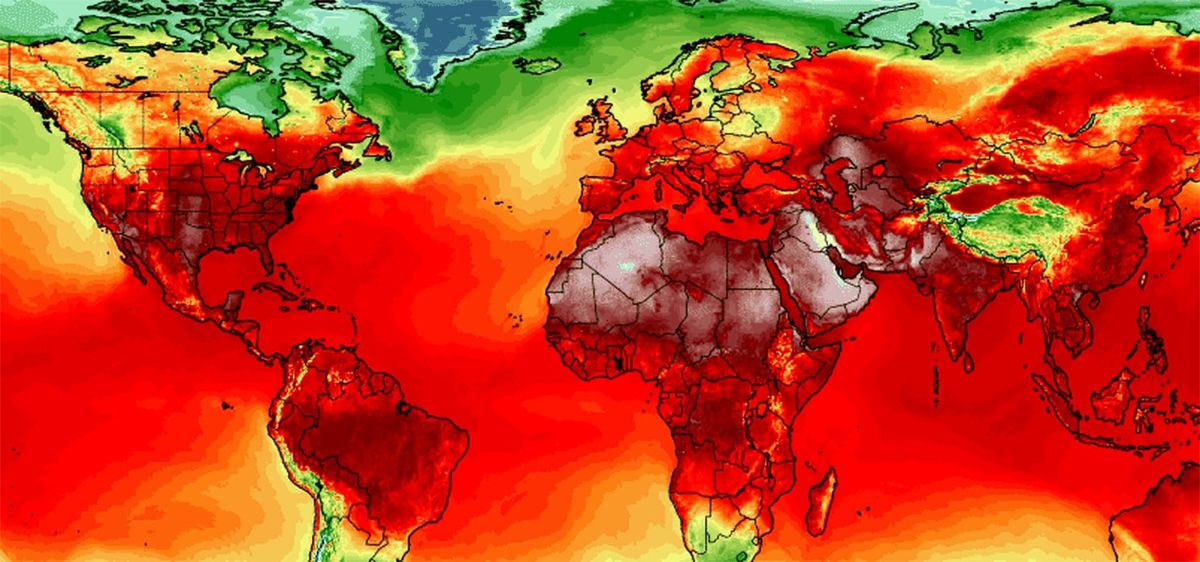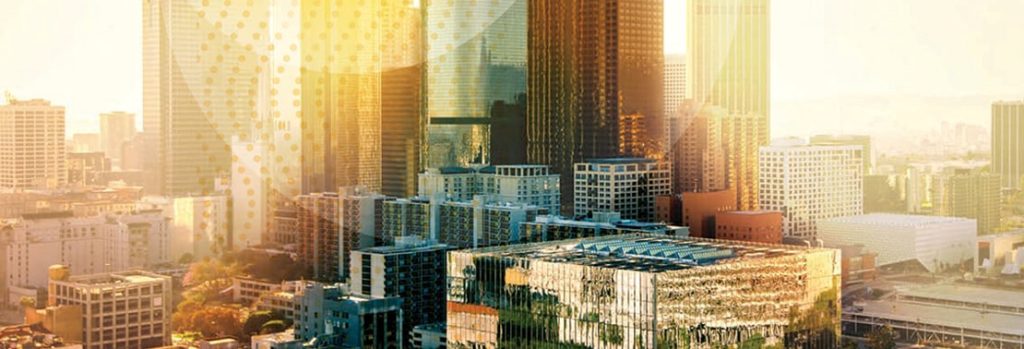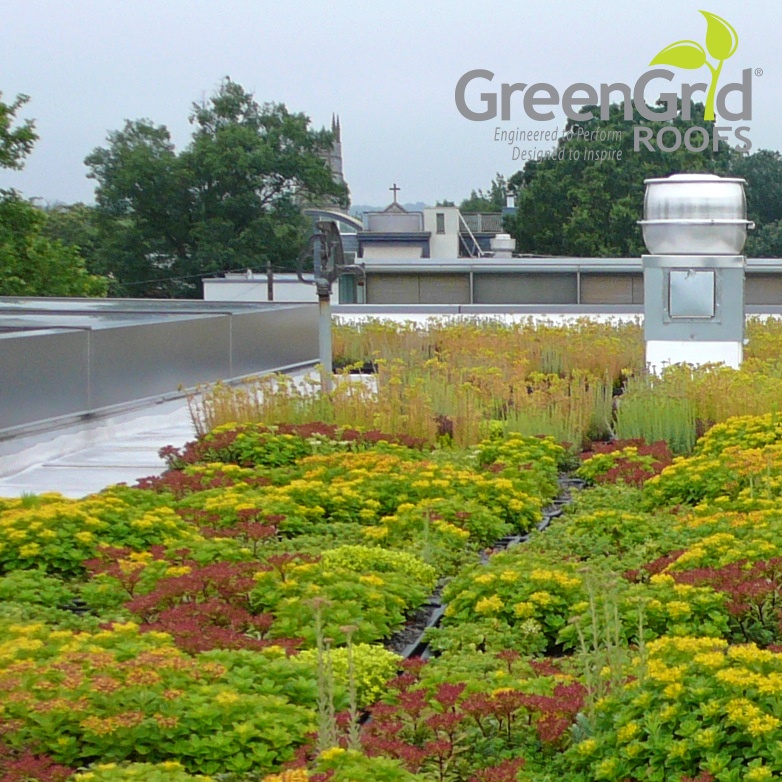Red-hot planet: simulation of maximum temperatures on July 3, 2018. Source: The Washington Post.
Intense Heat Equals Necessary Irrigation of Intensive Green Roof Systems
In July of this year the UK Met Office (officially the Meteorological Office) continued to report temperatures that were into the mid-30s (Celsius). Temperatures are touching these figures with frequency; for example, 33.3°C was recorded at Santon Downham on the 23rd July, 34.5° C at Heathrow Airport on 21st June 2017 and 36.7° C on the 01st July 2015 to name a few.
And the all-time record was 38.5° C at Faversham in August 2003. In fact, the average UK temperature over the last decade (2008-2017) was 0.8 °C warmer than the 1961-1990 average. (Source: UK Met office website).
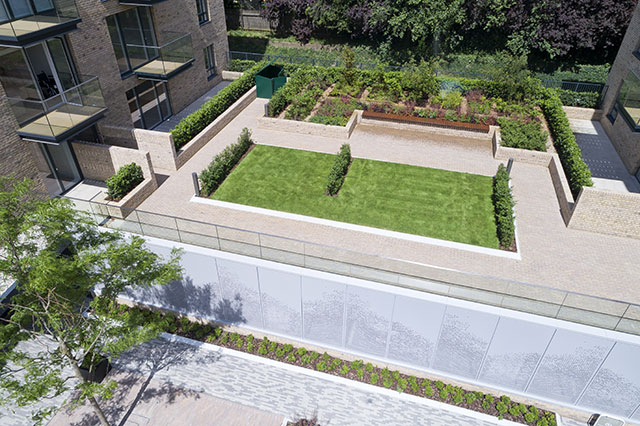
Intensive green roof system at Kew Bridge, London.
And we also know that global temperatures are following suit with heat waves wrecking havoc across the planet. 2018 is on pace to be the 4th-hottest year on record. (Source: National Oceanic and Atmospheric Administration (NOAA) via CNN).
This, to my mind, underlines the importance of considering very carefully the requirements for inclusion of permanent irrigation systems on intensive green roofs and in planters, whether they’re in London, Aberdeen, or wherever.
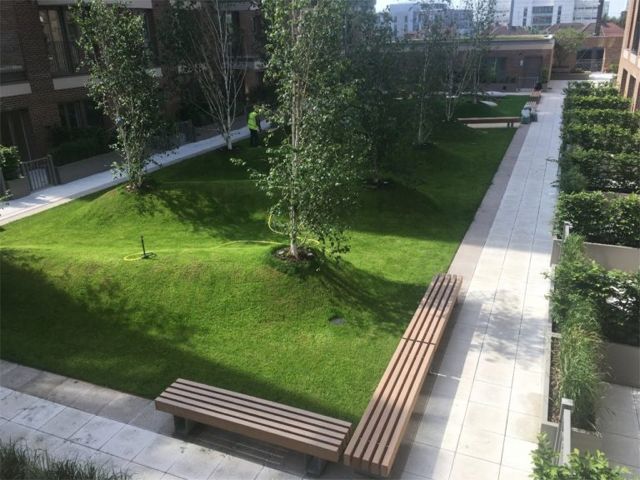
Intensive green roof & bespoke planters at Material Store, West London.
The total absence of or the provision of inadequate irrigation systems is one of the commonest reasons for planting failures on green roofs or within planters at either ground or roof level – regardless of rising heat rates. Here we take a quick look at some of the pressures and solutions for providing much-needed irrigation to our green spaces, but with an emphasis on green roofs.
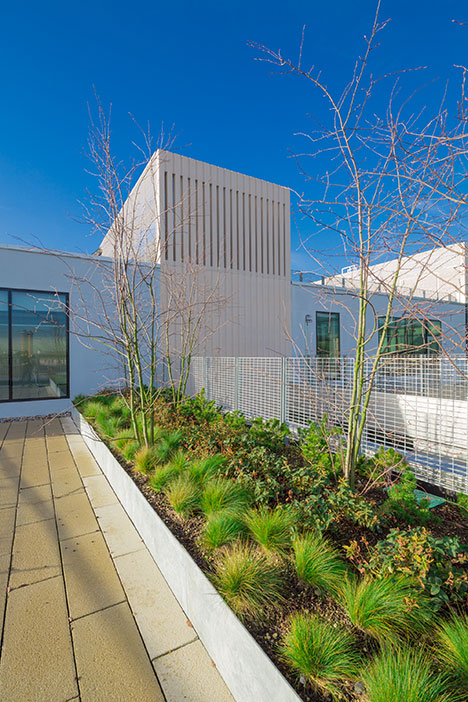
One of 14 landscaped roofs at the School of Architecture and Construction at the University of Greenwich, UK, a teaching resource.
With increasing urbanisation and higher density living, planners, landscape architects, and architects are trying to provide more affordable, high-quality, desirable living spaces that each have a sense of unique identity. And these locations very often incorporate green spaces or green elements within their designs.
This is all well and good. However, without providing the necessary elements for the plants to thrive, i.e., light, water, oxygen, carbon dioxide, nutrients, and a means to anchor their roots, no matter how well-meaning the intentions are, the long-term performance of the trees, shrubs or vegetation is undoubtedly compromised.
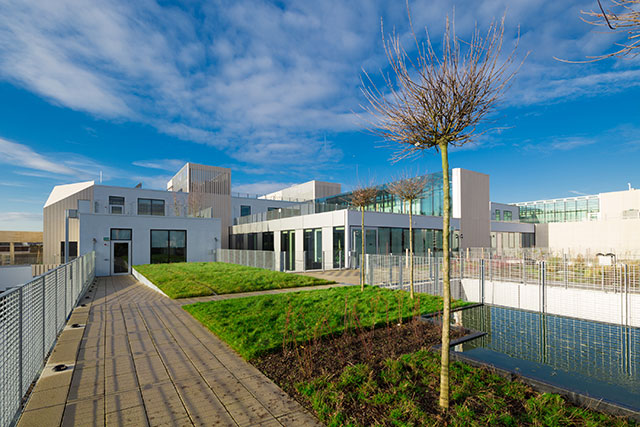
School of Architecture and Construction, University of Greenwich.
So why do we see so many planters incorporating trees and hedging that could quickly exceed these basic requirements for growth – least of all water?
There are numerous permanent irrigation solutions available on the market, supplied either as part of the planter/green roof solution or as optional extras – and these can either be automated or manually operated.
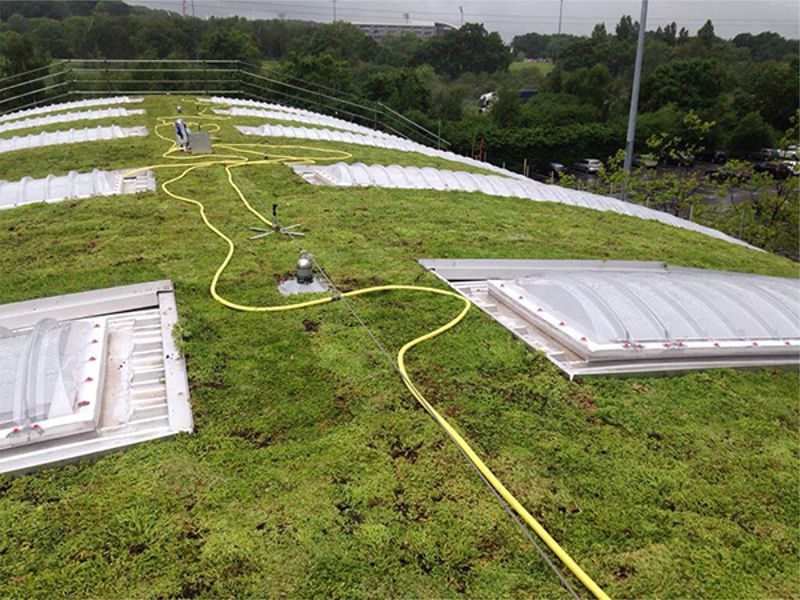
Extensive green roof at Pets at Home, Hedge End Retail Park, Southampton.
Why go to all the expense of providing a system, actually either intensive or extensive, and plantings and possibly missing out on years of enjoyment for a small increase in the installation cost?
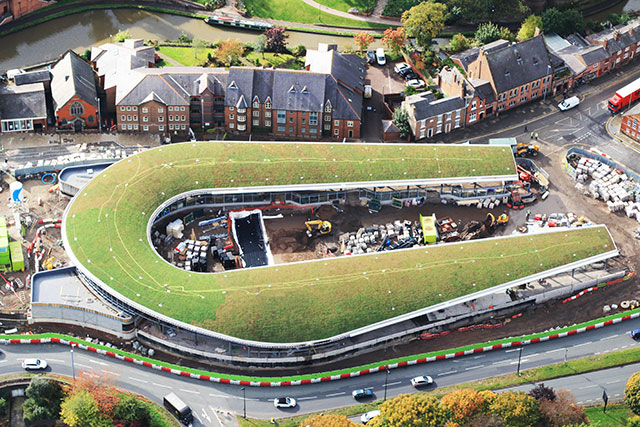
Chester Bus Interchange extensive green roof, UK.
Permanent Irrigation Components
Typically, but not necessarily exclusively, a permanent irrigation system includes the following components:
1. Mains water and power
2. Tank, pump and housing
3. Control box or programmer
4. Water feed pipes, solenoids and associated signal cabling
5. A means of applying the water, i.e., drippers or pop-up sprinklers
6. Finally, training!
There’s little point in offering an automatic irrigation system unless the operator understands how to program and operate the controls. Training for the FM (facilities management) provider or client is very important unless the irrigation system is operated remotely by a third party via the web.
This all might sound a bit complicated and another problem to think about, but you might be surprised at how compact and simple some of the systems are.
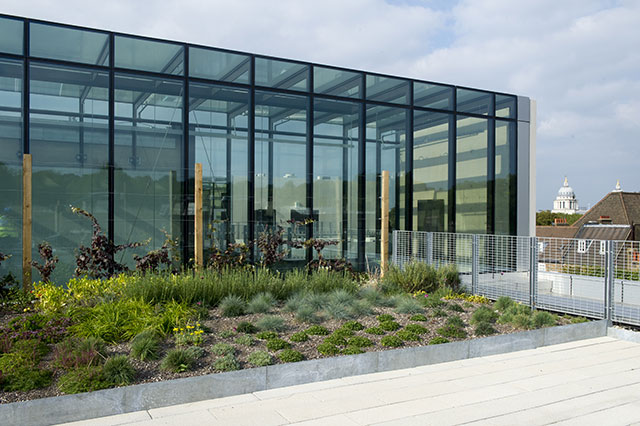
An integrated glasshouse for student projects on one of the green roofs at the School of Architecture and Construction, University of Greenwich.
Built-in Irrigation Reservoirs
Alternatively, if your pockets don’t stretch for an automated system, then there are many other non-automated solutions that could make a big difference to the performance, health and longevity of your planting – if there is a maintenance provider to actually manage them, regularly.
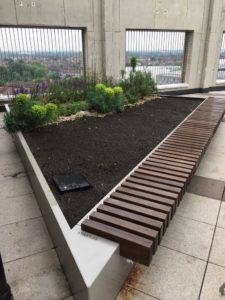
Material Store, West London.
Uniform planting – where there is a single form of planting such herbaceous perennials within an area of green roof then the application of water can be controlled by a single solenoid – a pressure compensated drip line can be installed and secured on the substrate surface, usually under the mulch layer. At the appropriate time of day (or night) the irrigation controller turns the water supply on for a set duration so irrigating the plants uniformly.
Mixed planting – where the planting is mixed, i.e., lawn, trees and herbaceous, then the theory remains the same but the method of application may vary, i.e., drip line for some areas and pop up sprinklers for the lawn. Each distinct type of planting could require its own solenoid to take into account the duration and quantity of water that is required for that particular type of planting.
Over application – to avoid over application of water to the planting beds, a simple soil moisture meter or rain gauge is incorporated into the control system circuit. This enables the irrigation controller to tailor the amount of water applied to each of the areas. However, owing to the proximity of some green roofs to building facades and the potential problems this could present with regards to rain shadow, or that radiated from the adjacent surfaces, more than one moisture sensor may be required and each one carefully located to reflect an accurate and true moisture reading.
By specifying the correct green roof system or planter to suit the final planting density and, very importantly, the carefully considered plant selection, applying sound annual horticultural practices such as mulching, feeding, a structured maintenance programme, and installing plants at a size that enables slow acclimatisation to their new environment can mean less reliance on expensive permanent irrigation systems.
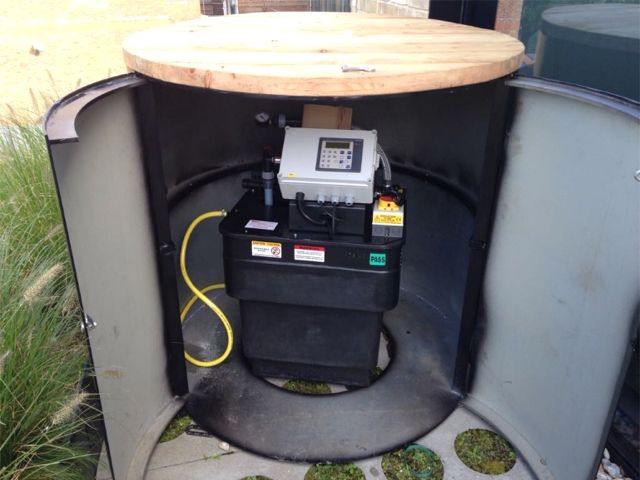
A custom made ‘garden table’ doubles up as the housing for a tank, pump, and controller unit for a mixed planting scheme in London.
It’s simple, unobtrusive and I expect most people wouldn’t even realize what was inside it as the pump operates during the night when the garden is less frequented. Alternatively, for larger and noisier units, the tank, pump, and controller can be located within a dedicated plant room away from the garden.
Consider Irrigation of Intensive Green Roof Systems Early
None of the above removes the requirement for good sound horticultural practice such as weeding, seasonal mulching, thinning out the plantings, appropriate feeding or installing the plants at a size that enables them to slowly acclimatise to their new environment.
Nor does it mean that the planting scheme should be less well adapted to cope with those peaks in temperatures that we’re increasingly experiencing. Including an irrigation system shouldn’t be seen as a temporary fix to enable unsuitable plantings to struggle through prolonged periods of high temperatures.
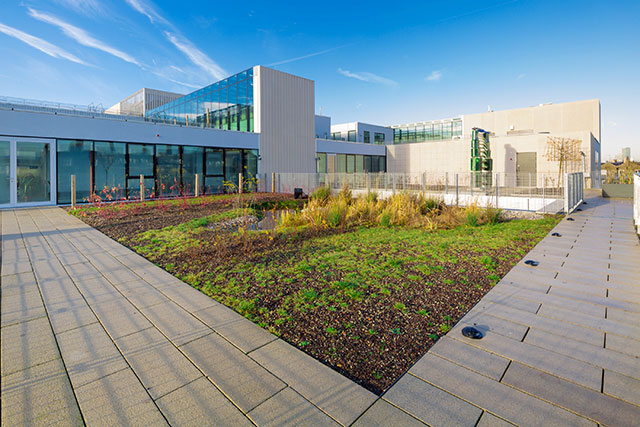
University of Greenwich.
We’re seeing increasing requests from clients to retrofit permanent irrigation systems on established, but possibly struggling, green roofs and planters. These retrofits are not only expensive, but cause disruption to tenants and client who are occupying the premises – disruption and expense that could have been avoided with more initial discussion during the concept and design stages of the project.
So to summarise, we are undoubtedly experiencing more frequent periods of unseasonably higher temperatures. Combine this with the already demanding environments of roofs, planters, and facades where we expect plants to not only grow, but to thrive. We need to be re-looking and re-appraising all aspects of the systems that we are offering – and asking ourselves ‘Can we do better?’ Only in this way can we help, in our small way, to make our urban spaces the pleasurable environments that they really ought to be.
~ By Adrian Culling
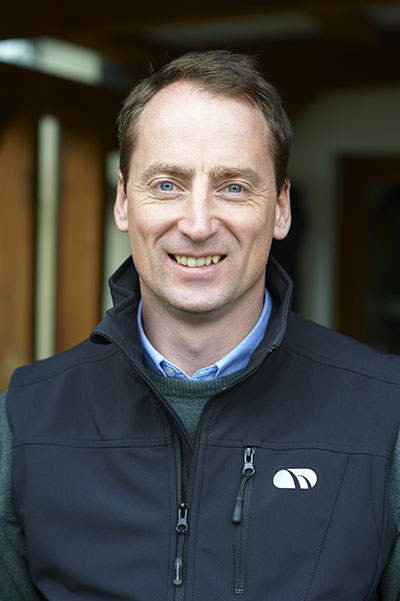
Adrian Culling returned to university to study for a degree in horticulture at Pershore College in Worcestershire in the late 90s. He has worked within the green roof industry, at Blackdown, for more than 10 years. Prior to this Adrian worked within private & public horticultural sectors of the industry and has been awarded medals at both RHS Hampton and Chelsea. Prior to retraining he worked within the environmental research industry in the UK and Europe.
Blackdown Green Roofs are available in three broad application categories including Extensive, Biodiverse, and Intensive and offer engineered living roof systems which are fully compatible with Alumasc Roofing System‘s warranted waterproofing ranges.
Contact Adrian Culling at info@alumasc-exteriors.co.uk and 03335 771 500.
 Greenroofs.comConnecting the Planet + Living Architecture
Greenroofs.comConnecting the Planet + Living Architecture
